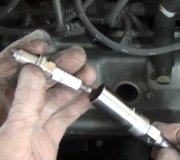Premium is just wasting money, nothing else. You're paying for something you don't need and can't use.
Gas formulations have changed a lot over the last decade. That includes the inability to store it for very long. I have an '80 Volare, (carburetor), and a '93 Dynasty, (fuel injected), both with over ten-year-old gas in their tanks, and they run fine. Everyone tells me with today's gas, you're lucky if it will burn after six months.
The issue with premium is not that it provides more power, as a lot of people mistakenly think. In fact, it allows the engine designer to build a more powerful engine, namely by raising the compression ratio. Doing that requires an additive that prevents pre-ignition, or spark knock. The lead used to do that. Today other additives do that.
Think of buying a rope to go mountain climbing. A rope capable of handling 500 pounds will be more than enough to get the job done. If you want to, you can "upgrade" to a rope that can handle 1,000 pounds. It's twice as big and heavy, and twice as expensive, but it will do what you need it to do. What would be the advantage to the stronger rope? It's the same idea with Premium gas. The engine will run on it, but it is actually much harder to ignite. If the ignition system is marginal, you are likely to end up with spark-related misfires.
Also think of a diesel engine. They run by the very high compression ratio raising the temperature of the fuel / air mixture until it self-ignites. That same high compression in a gas engine is what causes spark knock. The only way we used to be able to build high-performance engines in muscle cars was to raise the compression ratio. We were only able to do that if we used a higher-octane gas. The higher the octane rating, the harder it is to ignite that gas, and, once it has ignited, it is harder to keep the flame front moving across the entire cylinder. If the flame goes out before all the fuel is burned, it results in decreased power and seriously higher emissions. The goal is to run the lowest octane gas you can without getting spark knock. GM did that by adding knock sensors. Unfortunately, those also reacted to loose or sloppy timing chains slapping against the timing chain housing. The Engine Computer saw that as spark knock and retarded ignition timing until it stopped. That loose timing chain was the source of a lot of really rotten fuel mileage. Many people complained they couldn't even get 15 mpg.
The clinker here is a loose timing chain results in late valve timing, and that is one thing they use to adjust the "personality" of an engine to give it lots of low-end torque, such as for a motor home. That increased low-end power can make it look like the engine is really strong, but you give up high-end torque at the same time. That's why some tiny engines can squeal the tires at the stop sign, but you need a good mile to even think about passing someone.
Wednesday, December 6th, 2023 AT 6:20 PM




